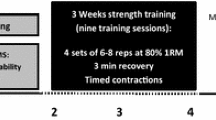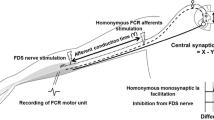Abstract
Electrical stimulation of the brachioradialis branch of the radial nerve has been shown to inhibit the discharge of voluntarily activated motor units in biceps brachii during weak contractions with the elbow flexor muscles. The purpose of the present study was to characterise the inhibitory reflex by comparing its strength in the short and long heads of the biceps brachii and examining the influence of forearm position on the strength of the reflex. Spike-triggered stimulation was used to assess the influence of radial nerve stimulation on the discharge of single motor units in the biceps brachii of 15 subjects. Stimulation of the radial nerve prolonged the interspike interval (P < 0.001) of motor units in the long (n = 31, 4.8 ± 5.6 ms) and short heads (n = 26, 8.1 ± 12.3 ms) of biceps brachii with no difference between the two heads (P = 0.11). The strength of inhibition varied with forearm position for motor units in both heads (n = 18, P < 0.05). The amount of inhibition was greatest in pronation (7.9 ± 8.9 ms), intermediate in neutral (5.8 ± 7.1 ms), and least in supination (2.8 ± 3.4 ms). These findings indicate that the inhibition evoked by afferent feedback from brachioradialis to low-threshold motor units (mean force 3–5% MVC) in biceps brachii varied with forearm posture yet was similar for the two heads of biceps brachii. This reflex pathway provides a mechanism to adjust the activation of biceps brachii with changes in forearm position, and represents a spinal basis for a muscle synergy in humans.








Similar content being viewed by others
References
Athwal GS, Steinmann SP, Rispoli DM (2007) The distal biceps tendon: footprint and relevant clinical anatomy. J Hand Surg [Am] 32:1225–1229
Baldissera F, Bellani G, Cavallari P, Lalli S (2000) Changes in the excitability of the H-reflex in wrist flexors related to the prone or supine position of the forearm in man. Neurosci Lett 295:105–108
Barry BK, Carson RG (2004) Transfer of resistance training to enhance rapid coordinated force production by older adults. Exp Brain Res 159:225–238
Barry BK, Pascoe MA, Jesunathadas M, Enoka RM (2007) Rate coding is compressed but variability is unaltered for motor units in a hand muscle of old adults. J Neurophysiol 97:3206–3218
Basmajian JV, Latif A (1957) Integrated actions and functions of the chief fexors of the elbow: a detailed electromyographic analysis. J Bone Joint Surg Am 39:1106–1118
Blackburn SC, Wood CP, Evans DJ, Watt DJ (2007) Radial nerve contribution to brachialis in the UK Caucasian population: position is predictable based on surface landmarks. Clin Anat 20:64–67
Buchanan TS, Almdale DP, Lewis JL, Rymer WZ (1986) Characteristics of synergic relations during isometric contractions of human elbow muscles. J Neurophysiol 56:1225–1241
Buchanan TS, Rovai GP, Rymer WZ (1989) Strategies for muscle activation during isometric torque generation at the human elbow. J Neurophysiol 62:1201–1212
Burke D, Gracies JM, Meunier S, Pierrot-Deseilligny E (1992) Changes in presynaptic inhibition of afferents to propriospinal-like neurones in man during voluntary contractions. J Physiol 449:673–687
Cavallari P, Katz R (1989) Pattern of projections of group I afferents from forearm muscles to motoneurones supplying biceps and triceps muscles in man. Exp Brain Res 78:465–478
Datta AK, Stephens JA (1981) The effects of digital nerve stimulation on the firing of motor units in human first dorsal interosseous muscle. J Physiol 318:501–510
Eames MH, Bain GI, Fogg QA, van Riet RP (2007) Distal biceps tendon anatomy: a cadaveric study. J Bone Joint Surg Am 89:1044–1049
Ellaway PH (1978) Cumulative sum technique and its application to the analysis of peristimulus time histograms. Electroencephalogr Clin Neurophysiol 45:302–304
Fournier E, Meunier S, Pierrot-Deseilligny E, Shindo M (1986) Evidence for interneuronally mediated Ia excitatory effects to human quadriceps motoneurones. J Physiol 377:143–169
Gielen CC, van Zuylen EJ (1986) Coordination of arm muscles during flexion and supination: application of the tensor analysis approach. Neuroscience 17:527–539
Herrmann U, Flanders M (1998) Directional tuning of single motor units. J Neurosci 18:8402–8416
Hultborn H, Meunier S, Morin C, Pierrot-Deseilligny E (1987) Assessing changes in presynaptic inhibition of I a fibres: a study in man and the cat. J Physiol 389:729–756
Jamison JC, Caldwell GE (1993) Muscle synergies and isometric torque production: influence of supination and pronation level on elbow flexion. J Neurophysiol 70:947–960
Jongen HA, Denier van der Gon JJ, Gielen CC (1989) Inhomogeneous activation of motoneurone pools as revealed by co-contraction of antagonistic human arm muscles. Exp Brain Res 75:555–562
Katz R, Penicaud A, Rossi A (1991) Reciprocal Ia inhibition between elbow flexors and extensors in the human. J Physiol 437:269–286
Mahakkanukrauh P, Somsarp V (2002) Dual innervation of the brachialis muscle. Clin Anat 15:206–209
Mattei B, Schmied A, Vedel JP (2003) Recurrent inhibition of wrist extensor motoneurones: a single unit study on a deafferented patient. J Physiol 549:975–984
Matthews PB (1996) Relationship of firing intervals of human motor units to the trajectory of post-spike after-hyperpolarization and synaptic noise. J Physiol 492(Pt 2):597–628
Miles TS, Le TH, Turker KS (1989) Biphasic inhibitory responses and their IPSPs evoked by tibial nerve stimulation in human soleus motor neurones. Exp Brain Res 77:637–645
Moritz CT, Barry BK, Pascoe MA, Enoka RM (2005) Discharge rate variability influences the variation in force fluctuations across the working range of a hand muscle. J Neurophysiol 93:2449–2459
Murray WM, Delp SL, Buchanan TS (1995) Variation of muscle moment arms with elbow and forearm position. J Biomech 28:513–525
Nafati G, Schmied A, Rossi-Durand C (2005) Changes in the inhibitory control exerted by the antagonist Ia afferents on human wrist extensor motor units during an attention-demanding motor task. J Neurophysiol 93:2350–2353
Naito A (2004) Electrophysiological studies of muscles in the human upper limb: the biceps brachii. Anat Sci Int 79:11–20
Naito A, Shindo M, Miyasaka T, Sun YJ, Morita H (1996) Inhibitory projection from brachioradialis to biceps brachii motoneurones in human. Exp Brain Res 111:483–486
Pascoe MA, Barry BK, Riley ZA, Enoka RM (2006) Identifying the source of radial nerve afferents that inhibit biceps brachii. Med Sci Sports Exerc 38:S372
Pierrot-Deseilligny E, Burke D (2005) The circuitry of the human spinal cord: Its role in motor control and movement disorders. Cambridge University Press, New York
Priori A, Berardelli A, Inghilleri M, Pedace F, Giovannelli M, Manfredi M (1998) Electrical stimulation over muscle tendons in humans. Evidence favouring presynaptic inhibition of Ia fibres due to the activation of group III tendon afferents. Brain 121(Pt 2):373–380
Riley ZA, Barry BK, Pascoe MA, Enoka RM (2006) Forearm posture and reflex inhibition from brachioradialis onto motor units in biceps brachii. Soc Neurosci Abstr #656.3
Shemmell J, Forner M, Tresilian JR, Riek S, Barry BK, Carson RG (2005) Neuromuscular adaptation during skill acquisition on a two degree-of-freedom target-acquisition task: isometric torque production. J Neurophysiol 94:3046–3057
Stephens JA, Usherwood TP, Garnett R (1976) Technique for studying synaptic connections of single motoneurones in man. Nature 263:343–344
ter Haar Romeny BM, Denier van der Gon JJ, Gielen CC (1982) Changes in recruitment order of motor units in the human biceps muscle. Exp Neurol 78:360–368
ter Haar Romeny BM, van der Gon JJ, Gielen CC (1984) Relation between location of a motor unit in the human biceps brachii and its critical firing levels for different tasks. Exp Neurol 85:631–650
Turker KS, Powers RK (1999) Effects of large excitatory and inhibitory inputs on motoneuron discharge rate and probability. J Neurophysiol 82:829–840
Turker KS, Powers RK (2003) Estimation of postsynaptic potentials in rat hypoglossal motoneurones: insights for human work. J Physiol 551:419–431
Turker KS, Powers RK (2005) Black box revisited: a technique for estimating postsynaptic potentials in neurons. Trends Neurosci 28:379–386
van Zuylen EJ, Gielen CC, Denier van der Gon JJ (1988) Coordination and inhomogeneous activation of human arm muscles during isometric torques. J Neurophysiol 60:1523–1548
Vicente DP, Calvet PF, Burgaya AC, Perez ML (2005) Innervation of biceps brachii and brachialis: anatomical and surgical approach. Clin Anat 18:186–194
Windhorst U, Hamm TM, Stuart DG (1989) On the function of muscle and reflex partitioning. Behav Brain Sci 12:629–681
Zhang L, Butler J, Nishida T, Nuber G, Huang H, Rymer WZ (1998) In vivo determination of the direction of rotation and moment-angle relationship of individual elbow muscles. J Biomech Eng 120:625–633
Acknowledgments
Brian J. Paulson, Elizabeth Terry, and Kristin E. Taylor assisted with data collection and analysis. This research was supported by NIH/NINDS NS43275 to RME.
Author information
Authors and Affiliations
Corresponding author
Rights and permissions
About this article
Cite this article
Barry, B.K., Riley, Z.A., Pascoe, M.A. et al. A spinal pathway between synergists can modulate activity in human elbow flexor muscles. Exp Brain Res 190, 347–359 (2008). https://doi.org/10.1007/s00221-008-1479-5
Received:
Accepted:
Published:
Issue Date:
DOI: https://doi.org/10.1007/s00221-008-1479-5




